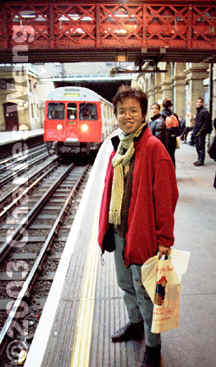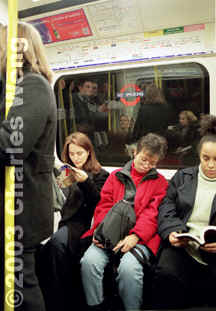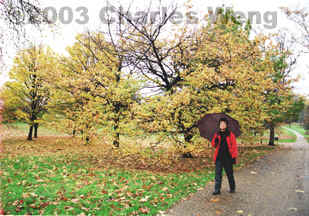- London Transportation Guide
- by a former resident
 |
FROM THE AIRPORTS: The best way to travel between London and its airports -- Heathrow, Gatwick, Luton and Stansted -- is by surface train. For £13.00, you can get on a comfortable train that runs between Heathrow and Paddington Station every 15 minutes, which happens to be the length of the ride. There is train service between Gatwick and Victoria Station, and between Stansted and Liverpool Street. London
Underground (see below) also runs to Heathrow and Gatwick, but the wait
and the ride are significantly longer, and itís sardine-packed during
weekday rush hour.
If you must watch your bottom line, however, it is the cheapest
way to get to town: £4.50 from Heathrow to any Zone 1 stop, between
Olympia Station and East End. |
|
| Donít
bother with the coaches and taxis unless itís already arranged
beforehand. Itís just as costly as the surface trains, and itís
absolutely certain that you will be trapped in traffic.
If you have a car and you plan to see much of Britain outside
London, the recommended strategy is to book your hotel room in a suburb,
and commute to the capital by public transportation.
Few things will frustrate you more than finding a parking space
in the City.
RIDE THE TUBE: The most efficient, cost-effective and weather-proof means of getting around town by far is the celebrated London Underground, which even after a century and a half remains arguably the most extensive and user-friendly subway system in the world. |
||
|
|
The Tube has convenient stations at every tourist attraction, surface rail station, and the two busiest airports. In central London, the distance between two stops is so short that leisurely travelers need not worry about skipping one. Transfer from one line to another is always a short distance down a corridor or up an escalator. Street musicians (buskers) create an uplifting ambience throughout the West End stops, especially at night. The only caveat is the frequency of shutdowns along certain sections for maintenance and security alerts, as well as the intermittent strikes by Tube operators trying to improve their lot whilst more bits and pieces of the Underground become privatised. During these lapses of efficiency, the remaining trains are as sausage-stuffed as any Shinkensen in downtown Tokyo. Regardless, more Londoners still gather along the Tube than at any other public venue, a fact well known to prospective terrorists. Should you be paranoid about that and a claustrophobe to boot, perhaps the Tube is not for you. |
|
| It's hot down there! In September 2002, two Central Line trains were stuck for about an hour, trapping 2000 riders in the infernal dark and causing three to faint. Nine months later, I experienced firsthand what it was like to be stuffed into a packed Central Line train whilst temperatures neared 30ļC (90ļF). Mayor Livingstone is offering £100K to anyone who can keep the riders cool during the summer...are you up to the task? Read the 16 July 2003 BBC story here for some brilliant ideas already being considered. | ||
|
|
BUSES: The beloved red double-deckers are a fun way to catch the sights as you get from points A to B. You'd think these lumbering hulks are as good as beached whales during rush hour, but they do still get by, thanks to the many special lanes reserved for them and the taxis. That said, they tend to get very packed in the evening, and getting on and (especially) off can be quite a test of daring. Amongst the older buses with rear access, it's common to see people leaping off even as the bus is already moving. Buses become much more important as you leave the
city centres, where Tube stations are fewer and farther in between. If
youíre heading for the weekend street markets at Portebello or Camden
Town, chances are you will drop a modest £1 into a box near the bus
driver, or simply flash your Underground day pass. |
|
| TAXIS:
As with the Cockney carriage drivers of yore, the cabbies in
their signature black cars are a good source of local gossip. These
days, your friendly driver may hail from as close as Brixton or as far
as Bermuda, Benin and Bangladesh. Like
the buses, they are prone to road congestion and are best used at
leisure. If youíre
image-conscious, there is no better way to make an exit from a West End
theatre or nightclub than to hop into an expecting cab.
It needs not be said that, short of hiring your own vehicle, this
is the most expensive way of getting around. |
||
|
|
YOUR
FEET: Barring
intolerable weather, youíll be surprised by how far you can walk.
On a sunny summer day, a leisurely (albeit sweaty) one-way walk
from the Tower of London to Royal Albert Hall is very feasible. For pub hopping, after-theatre dining and
clubbing, there is no other way to take in the full spectacle of London
nightlife than being a pedestrian. Itís only ten minutes on foot
between the hubs of hubbub: Trafalgar Square, Piccadilly Circus,
Leicester Square, Oxford Circus and Covent Garden. |
|
Londonís two larger parks, Regentís Park and Hyde Park, are indeed surrounded by bus stops and Tube stations, but donít expect a subway entrance in the middle of the greenery. If you want a brief respite from city traffic, be sure to have comfortable shoes.
YOUR CAR: Leave it.
ESCAPING LONDON BY TRAIN: The recent policy of slowing trains down to 20 mph over certain tracks may make it longer to reach such popular day-trip destinations as Hampton Court, Oxford, Bath, Brighton and Canterbury, but for every sucker whoíd rather park his car along the length of the M16 there is just more space for you and yours in the toasty train cabins.
Most tourists will remember the following railway stations in London, which are all conveniently connected via the Tube and the bus networks:
|
WATERLOO for the Continent via the Eurostar trains (transfer to TGV in Paris) | |
|
KINGS CROSS & ST PANCRAS for the North, Yorkshire and Scotland (and to Hogwarts from Platform 9-3/4) | |
|
EUSTON for the Midlands, North Wales, the North West (e.g., the Lake District), and Scotland | |
|
VICTORIA for Kent, Cornwall, the South Coast, Gatwick Airport | |
|
PADDINGTON for Oxford, Bath, South Wales, and Heathrow Airport | |
|
LIVERPOOL STREET for East Anglia, Northumberland, and Stansted Airport |
It is with trepidation and hope for this rail enthusiast to note that the British rail system is re-emerging from a deplorable safety record. Since 1995, there have been no less than seven fatal accidents, once unheard of in the country where locomotive travel was invented two centuries ago. Massive spending is already underway to upgrade tracks and safety systems throughout the UK, but the derailment at Potters Bar in May 2002 -- just a few miles away from the 1997 crash in Southhall, the 1999 collision near Paddington Station, and the 2000 wreck at Hatfield -- only showed that much is to be done.
The photos above were taken with a Nikon F100 with f2.8 28mm Nikon AF D lens, and Fujicolor NPH135 ISO 400 film.
| Back to top |



